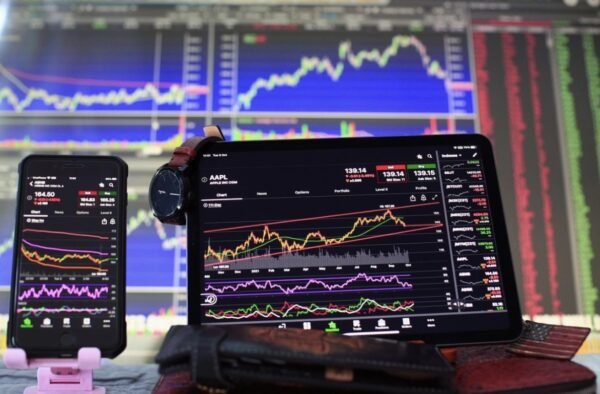
Automated CFD Trading: A Beginner’s Guide

When participating in CFD trading, investors usually consider how they can manage their investments and improve efficiency. That’s where automated trading comes in. Automated trading can make your trades more efficient and increase the speed of trade executions, allowing you to save time and energy on your trading process, generating a profit without lifting a finger. This guide looks closely at what automated CFD trading is and how you can get started.
What Does Automated Trading Mean?
Contract for Differences (CFD) trading involves speculating on the market’s price direction. They are derivative instruments that will trade depending on how much the asset price is and the direction in which it moves over a period.
Automated trading involves participating in financial markets with a program or robot that executes your trades automatically. All you have to do is set the entry and exit conditions of the trade, and the bot will carry out the process for you. With automated CFD trading, all your trades are automatically managed, so you don’t have to spend all your time monitoring the positions.
Automating your CFD trading also involves carrying out multiple trades in a short time. Plus, there are no emotional decisions or FOMO involved since the computer has already built in the rules of the trade. Automated trading allows you to input strategies and trends into the parameters.
How Does Automated CFD Trading Work?
Automated Contracts for Difference trading works by predicting the rise or fall of the market price with CFD trades. If you’re a beginner, you can easily understand the process by using a reliable trading platform offering automated CFDs.
Start by choosing a platform to sign up to, then set the parameters of your trading strategy. Create a set of rules and conditions for your CFD trades, and the algorithm will apply the criteria, placing trades on your behalf.
You should base the parameters you set for your CFD trading on the trade’s timing and quantity and the price at which the trade should be opened or closed. For instance, you can input: buy 100 Apple shares when the 50-day moving average exceeds the 200-day average.
Remember that CFD trading involves trading on the differences in position prices, so you don’t own the underlying asset. Instead, you only gain money on the price changes of that asset. When you set the automated CFD trading strategy, the system will monitor the financial market prices. Then, when the parameters are met, the trades are automatically executed.
The primary purpose of automated CFD trading is to execute trades fast and efficiently and take advantage of trading opportunities and market events. The trades are leveraged because they are based on automated CFDs. So, you will put down a small margin to get access to a larger position. Although automated CFD trading is beneficial, keeping an eye on your trades is still essential.
How To Get Started With Automated Trading

To automate your CFD trades, you need to follow the steps below:
- Open a CFD account: Start by opening a live CF account and verify your identity. Then, you can fund the account and start trading.
- Pick the automated trading platform suitable for you: You can consider different platforms like ProRealTime and MetaTrader or build your API.
- Set up your trading strategy to execute the trades: Choose a timeframe, such as day trading, swing trading, position trading, or scalping.
- Stay up to date: While executing trades, study the market, stay updated on the news, and learn more about technical and fundamental analysis.
Using MetaTrader or an API
Two popular ways to automate your CFD trading are to use MetaTrader or build an API. MetaTrader 5, the newest version, comes with features for automated trading. It is a well-known trading platform with a robot that automatically places CFD trades for you and manages the position sizes.
If you have experience in coding, you can consider creating your own program to automate trades. Building an API is convenient for programmers; you can connect this to your CFD trading platform. Connecting AI to your broker can differ based on the platform. Check the API documentation of the CFD broker for precise information.
Advantages of Using Automated Trading for CFDs

Although CFDs are risky since they use leverage, they can increase your profits when you follow the right strategy. When using automated CFD trading, keep the risks in mind. But the advantages are worth looking forward to.
Objective Trading
When you use automated CFD trading, there is no impulsive or emotional decision-making involved. Orders are processed immediately after you set the parameters. Fear of missing out, greed, and other emotional factors that can affect the trade are reduced.
Backtesting
Automated CFD trading allows you to backtest strategies before executing trades automatically. You can evaluate the strategy based on historical data. If it works for your investment goals, you can set the bots to carry out your trades like that.
Speed and Efficiency
With automated trading, you can increase the speed and consistency of your CFD trades. These automated systems can analyze your market condition, execute trades with minimal delay, identify trading opportunities, and place orders faster.
Risk Management
Automated CFD trading allows you to execute risk management measures like trailing stops, stop-loss orders, and profit targets. All of these are settings automatically applied to reduce risk.
Diversification
With automated trading, you can execute multiple trading strategies simultaneously, giving you access to different markets and CFD instruments.
Bottom Line: Benefit From Automated CFD Trading
Automated CFD trading suits you if you want to trade your CFDs according to set parameters. This can work if you want to avoid emotional trading, are busy, or don’t want to spend too much time monitoring your positions. With automated CFD trading, you get a low-maintenance strategy with advanced technology.














































